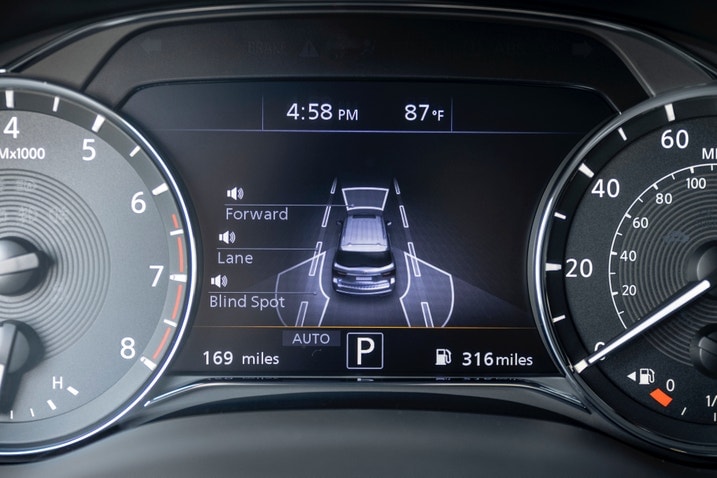With a seemingly endless list of acronyms and abbreviations, the ins and outs of modern vehicle technology can be confusing. A lane keeping assist system, or LKAS, is a driver assist feature that works by making small automatic corrections to the steering to keep the vehicle between clearly marked lane lines.
Also known as "active lane keeping" or "road departure prevention," LKAS is one step beyond the simpler, less sophisticated lane departure warning (LDW), which merely alerts the driver to an impending lane change rather than providing steering inputs. On the other hand, LKAS isn't quite as slick as lane centering, which attempts to keep the car evenly spaced between clearly marked lines.
How does lane keeping assist work?
Vehicles with LKAS have one or more cameras to detect lane markings painted on the road surface. These cameras can be mounted high in the windshield or the sideview mirrors and sense both dotted and solid lane lines.
If the driver strays too close to a marking or crosses it, LKAS can provide steering inputs to bring the car back into the lane. It also alerts the driver via audible alerts, flashing warning lights, and/or vibrations in the seat or steering wheel. Lane keeping assistance doesn't need two lines to work — if only one lane marking is present, it will track that line and help reduce incursions across it. If the driver activates the turn signal, LKAS will temporarily deactivate rather than put up a fight against a legal lane change.
LKAS is a handy tool that helps drivers stay clued into what's happening on the pavement, but it's not foolproof. It requires the person behind the wheel to remain in control of the vehicle with both hands on the wheel. Unlike more advanced driver assistance features, LKAS doesn't actively prevent lane departures. LKAS also depends on clearly seeing marked lane lines, so decaying pavement and blind shoulders can throw it off. Snow and dust can also reduce the system's efficacy, either by blocking the cameras or accumulating on the road. Finally, LKAS doesn't work at all speeds on every vehicle.
How do you activate or deactivate the lane keeping assist system?
On most cars, LKAS is activated by default. An icon on the dashboard, usually a green top-view pictograph of a car drifting across a dotted lane line, will let you know the system is on and working properly.
Turning it off is usually relatively simple. There may be a button marked with the LKAS icon, and pressing it can activate or deactivate the system. On some cars, you need to delve into the infotainment system or instrument cluster display, and the process varies from model to model. Temporarily ditching LKAS can actually be helpful when driving through a construction zone or over snowy pavement since the system could be confused by inconsistent lane lines.
However, we don't recommend deactivating LKAS except in those rare circumstances. Although tugging at the wheel when straying over lane markings can feel intrusive at first, it can help a driver be more attentive to the road ahead and prevent a serious crash caused by an accidental lane departure.
What cars have a lane keeping assist system?
LKAS is becoming increasingly commonplace, even among the cheapest cars on the market today. For example, it's standard equipment on every Edmunds Top Rated vehicle, including the reasonably priced Toyota Prius and the midsize Chevrolet Colorado pickup. LKAS is also found on the value-packed Chevrolet Trax and Buick Envista crossovers, as well as the Kia Soul hatchback. Many automakers, such as Honda, Hyundai and Toyota, include it as standard on every vehicle they sell.
It's often bundled together with a variety of new car safety suites. Some brand names to keep an eye out for are:
AcuraWatch
Audi Pre Sense
BMW Lane Keeping Assistant
Chevy Safety Assist
Ford Co-Pilot360
Honda Sensing
Mercedes-Benz Driver Assistance Plus
Nissan Safety Shield 360
Subaru EyeSight
Toyota Safety Sense
These advanced driver assistance suites all include automatic emergency braking, and some also get trick features like driver attention monitoring, blind-spot warning and adaptive cruise control.
Is lane keeping assist effective?
Apart from the aforementioned circumstances — road construction, lane closures, and inclement weather — LKAS tends to work pretty well. However, if the windshield or sideview mirror cameras are damaged, the vehicle will automatically disable lane keep assist. Repairing the damaged parts will also require recalibrating the system, a feat that dealerships and reputable auto glass and body shops can carry out.
Software bugs can also hamper the effectiveness of LKAS. Sometimes, the solution is as simple as turning the car off for several seconds and turning it back on again. Some cars also include a master reset function in the infotainment system that can knock the software back into line. If all else fails, a dealer or auto repair shop will likely have the answers.
